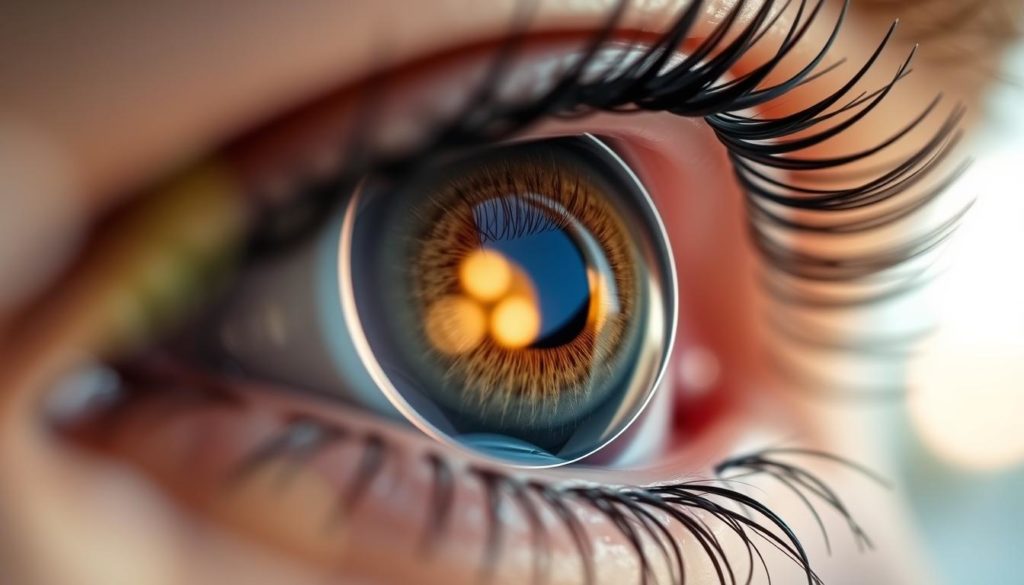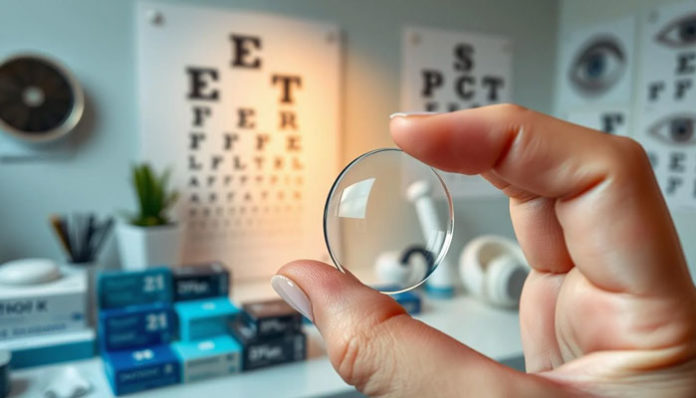Did you know over 40 million Americans use contact lenses? Many still face daytime discomfort and dryness. But, what if you could have clear vision without daytime lenses or glasses? Orthokeratology is a breakthrough that offers natural vision improvement without surgery.
Orthokeratology, or Ortho-K, is a new way to correct vision. It reshapes the cornea to fix myopia, hyperopia, and astigmatism. By wearing special gas permeable lenses at night, you can see clearly during the day without glasses or lenses.
Learning about Orthokeratology is key for those looking for new ways to correct vision. It’s a non-invasive option for natural vision improvement. Let’s explore Orthokeratology’s benefits, how it works, and why it’s different from other methods.
What is Orthokeratology?
Orthokeratology, or Ortho-K, is a new way to correct vision. It uses special contact lenses to reshape the cornea. This lets people see clearly without glasses or daytime contacts.

Definition and Background
Ortho-K started in the 1960s. It was found that glass scleral lenses could change the cornea’s shape. Now, modern Ortho-K lenses can greatly improve vision overnight.
By wearing these lenses at night, people can see clearly during the day.
How it Differs from Other Vision Correction Techniques
Ortho-K changes the cornea’s shape, unlike glasses or regular contacts. It’s a unique method that’s also reversible. This is different from LASIK, which changes the cornea forever.
Orthokeratology is special because it gives clear vision during the day. It doesn’t need daily wear or surgery. It’s a temporary but effective way to improve vision.
The Benefits of Orthokeratology
Orthokeratology, or Ortho-K, has many benefits. It helps people see clearly without glasses. It’s also great for controlling myopia, or nearsightedness.
Daytime Vision without Glasses
Ortho-K lets you see clearly all day. It’s perfect for athletes and those who are always on the move. No more dealing with glasses getting in the way.

Myopia Control Methods
Ortho-K is also good for kids. It helps slow down myopia as their eyes grow. It’s a smart way to manage shortsightedness over time.
Safety and Effectiveness
Many studies show Ortho-K is safe and works well. If you take care of your lenses and follow your eye doctor’s advice, you’ll likely see great results. The lenses reshape your cornea while you sleep, so you wake up with clear vision.
| Benefits | Explanation |
|---|---|
| Daytime Vision | Clear vision without the need for glasses or contact lenses during the day. |
| Myopia Control | Slows down the progression of myopia, particularly effective in children. |
| Safety and Effectiveness | Proven through clinical studies, with high success rates among adherents. |
The Ortho-K Process: What to Expect
The Ortho-K process starts with a detailed initial consultation with your eye care expert. They will check if you’re right for Ortho-K by looking at your eye health and how your eyes work. This first check is key for the best results.
Initial Consultation
In the first meeting, your eye doctor will do several tests. They will measure your vision, check your cornea shape, and look at your eye health. This helps make sure your eyes can handle Ortho-K lenses.
Fitting Your Ortho-K Lenses
If you’re a good fit, the next step is fitting your Ortho-K lenses. Your eye doctor will take precise measurements to make lenses that fit you perfectly. Getting the fit right is important for comfort and success. It might take a few tries to get it just right.
After getting your lenses, you’ll learn how to care for them. You might feel some discomfort at first as your corneas adjust. But your eye doctor will help you through this. By following their advice, you’ll have a great experience with Ortho-K.
Understanding Orthokeratology for Myopia Control
Orthokeratology, or Ortho-K, is a non-surgical way to correct vision. It reshapes the cornea temporarily. This makes vision clear during the day and helps slow down myopia.
It’s great for kids and teens whose eyes change fast.
How Orthokeratology Helps Manage Myopia
Ortho-K lenses flatten the cornea. This focuses light on the retina. It improves vision and might slow down myopia.
Studies show Ortho-K can slow down myopia. It’s a good choice for managing myopia over time.
Who Can Benefit from Ortho-K for Myopia Control
Orthokeratology is good for those looking for other ways to control myopia. It’s especially helpful for kids and teens with fast-changing vision.
It can make daytime vision clearer. It also reduces the need for glasses or contacts.
Adults who play sports or have jobs that don’t fit with glasses or contacts can also benefit. It’s a good option for those who can’t have LASIK.
Choosing Ortho-K can improve your life. It manages myopia and gives you better vision freedom.
How Ortho-K Lenses Work
Ortho-K lenses are made to fix vision temporarily by reshaping the cornea while you sleep. Knowing how they work and how to care for them daily is key to getting the most out of them.
Mechanism of Corneal Reshaping
Ortho-K lenses gently press on the cornea to change its shape. This change happens mainly while you sleep. The lenses use special pressure to reshape the cornea.
Each lens is made just for you, based on how your cornea looks. This reshaping lets you see clearly during the day without glasses or contacts.
Daily Care and Maintenance
Keeping Ortho-K lenses working well means following a strict care routine. You need to clean them every day to get rid of protein and bacteria. It’s also important to store them in a clean, sterile case with fresh solution.
Seeing your eye doctor regularly is crucial. They check if your eyes and lenses are healthy. Following these steps helps keep your vision clear and avoids problems.
| Care Aspect | Details |
|---|---|
| Cleaning | Use a prescribed cleaning solution to disinfect the lenses daily. |
| Storage | Store lenses in a clean, sterile case with fresh solution each night. |
| Check-ups | Visit your eye care professional regularly to monitor eye health and lens fit. |
Potential Candidates for Orthokeratology
Finding potential Ortho-K candidates is key for the best results. People with mild to moderate myopia do well. This includes those with prescriptions up to -6.00 diopters and little astigmatism. They are the best vision correction candidates for Ortho-K.
Healthy eyes are a must. Candidates should not have eye problems that could mess with Ortho-K. Also, having a flexible lifestyle is important. The success of Ortho-K depends on wearing the special lenses only at night.
Ortho-K is great for kids and teens to stop myopia from getting worse. But, adults who don’t want LASIK or can’t have laser eye surgery also find it helpful.
To see if you’re a good fit, get an eye check-up. An eye doctor can tell if Orthokeratology is right for you. This way, you can join the many happy vision correction candidates.
Preparing for Your Ortho-K Consultation
Getting ready for your Ortho-K consultation is a key step towards better vision. You’ll have a detailed eye care discussion during the appointment. This covers all aspects of the procedure.
What to Discuss with Your Eye Care Professional
Before your Ortho-K consultation, share your vision history and any past treatments. Talk about the vision improvements you hope for, how long it will take, and any side effects. Knowing the cost and follow-up care needed is also important for a full eye care discussion.
Questions to Ask During the Consultation
It’s good to have questions ready for your Ortho-K consultation. This ensures you cover all important points. Here are some questions to consider:
- How often will I need to replace the lenses?
- What strategies can I use to handle possible discomfort?
- What should I do in case of an emergency?
A well-prepared patient is more likely to make informed decisions about their eye health. They’ll be better equipped to decide if Ortho-K is right for them.
| Discussion Topic | Key Points |
|---|---|
| Vision History | Share past corrective measures and current concerns |
| Expected Outcomes | Understand the potential vision improvements and the timeframe for results |
| Side Effects | Ask about possible side effects and how to manage them |
| Cost | Clarify the cost of the procedure and any follow-up care required |
| Lens Replacement | Inquire about the frequency of lens replacement |
| Discomfort Management | Learn strategies for handling discomfort |
| Emergency Protocol | Know what actions to take in case of an emergency |
Exploring the Success Rate of Orthokeratology
Looking into Orthokeratology’s success rate can guide those thinking about it. Studies show it works well for many people.
Clinical Studies and Results
Many studies on Ortho-K show it’s effective for most patients. They found it slows down myopia in kids and improves vision. Ortho-K is proven to help with myopia and boost vision quality.
Patient Testimonials
People who’ve tried Ortho-K lenses share their good experiences. They love not needing glasses during the day. Their stories show how happy they are with their vision.
In summary, Orthokeratology’s success is backed by science and personal stories. If you’re thinking about it, look at both to see if it’s right for you.
FAQ
What is Orthokeratology?
Orthokeratology, or Ortho-K, is a non-surgical method to improve vision. It uses special gas permeable contact lenses worn at night. This method gives clear vision during the day without glasses or contacts.
How does Ortho-K work for myopia control?
Ortho-K works by flattening the cornea. This reshapes how light hits the retina, improving vision. It also helps slow down the growth of the eyeball, which can help control myopia, especially in kids and teens.
What are the benefits of Orthokeratology?
The main benefits include clear vision during the day without glasses or contacts. It also helps control myopia, especially in children. Plus, it’s a safe and reversible option.
How does the Ortho-K process start?
It starts with a consultation to see if Ortho-K is right for you. An eye doctor will check your vision, cornea health, and overall eye condition. Then, they’ll take measurements to make custom lenses for you.
Who are ideal candidates for Orthokeratology?
People with mild to moderate myopia (up to -6.00 diopters) and little astigmatism are good candidates. It’s great for kids and teens to control myopia and for adults who want a non-surgical fix.
How do Ortho-K lenses reshape the cornea?
Ortho-K lenses apply pressure to the cornea to change its shape. This reshaping happens while you sleep. It allows for clear vision during the day.
How should I prepare for my Ortho-K consultation?
Bring info about your vision history and any previous treatments. Talk about your concerns and ask about expected results, side effects, costs, and follow-up care.
What is the success rate of Orthokeratology?
Studies show Ortho-K works well for most people. Many users see big improvements in their vision and quality of life. People often say they’re very happy with the results.
How is Ortho-K different from other vision correction techniques?
Unlike glasses or contacts that just correct vision, Ortho-K changes the cornea shape. It’s a non-surgical, reversible way to correct vision without needing to wear lenses during the day or undergoing surgery.
Is Orthokeratology safe and effective?
Yes, Ortho-K is safe and effective when done right. Studies back its success, especially in stopping myopia from getting worse. Following care and maintenance tips is key for safety and success.
What are some daily care and maintenance tips for Ortho-K lenses?
Clean and store the lenses as directed. Keep good hygiene and go for regular check-ups. This ensures the lenses work well and your corneas stay healthy.


